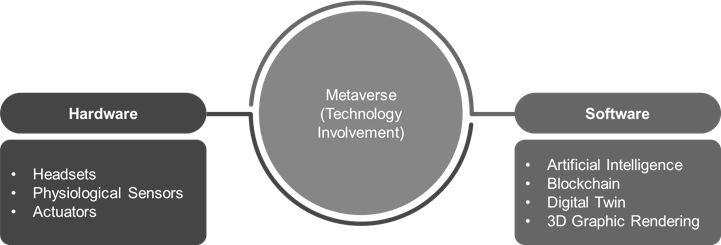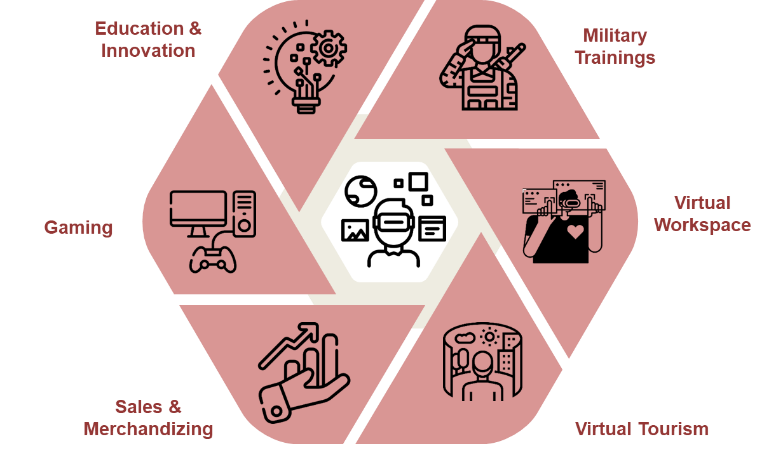The metaverse was first defined as a fictional concept in 1992 in the novel “Snow Crash” by Neal Stephenson, where people can feel and interact with objects and other people in the virtual world. The systems based on the metaverse mainly utilize various hardware and software to create virtual environments.
Today, the metaverse is engaged with different technologies such as virtual reality, mixed reality, artificial intelligence, and others to create a virtual environment where users can perform various tasks and actions related to different application areas such as education, gaming, sales, and merchandising, virtual tours, military training, and others.
What is Metaverse?
It combines multiple technology elements, including virtual reality (VR), augmented reality (AR), and live user videos, within a digital world. The metaverse concept is based on the convergence of multiple technologies, allowing users to interact multisensorily with digital objects and other people in a virtual environment. It enables users to work, play, and stay connected with other users through everything from concerts and conferences to virtual trips to different places worldwide.
Metaverse: Technology Involvement

Hardware
To introduce metaverse in the industries, the following hardware components are being considered:
- Headsets: Advancements in manufacturing headsets have made it possible to introduce virtual reality to the real world. The user can have real-world experience in the virtual environment by using headsets. It is possible to implement the metaverse using extended reality headsets. The extended reality headsets will provide users with the experience of a collaborative environment in the metaverse.
- Physiological Sensors: Physiological sensors can be very helpful in implementing the metaverse in the real world. These sensors will help move the avatars in the metaverse based on their movements in the real world, enhancing the experience at a whole new level.
- Actuators: Recent advancements have focused on enhancing the virtual world experience more realistically. The actuators will enable users to visualize and experience real-world objects in the virtual environment. The experience of sensing an object in the real world will be translated into a similar experience in the metaverse.
Software
To introduce metaverse in the industries, the following software components are being considered:
- Artificial Intelligence: Artificial intelligence (AI) can process a large amount of data in less time, which provides a smoother visual experience. For a much more realistic gaming experience in the metaverse, AI can help operate non-player characters (NPCs) to act according to the scenario. AI can also provide unique outputs and solutions by processing previously stored data.
- Blockchain Technology: The introduction of blockchain technology in the metaverse can be a key to problems related to interoperability and accessibility. Blockchain technology can provide localized and transparent solutions to digital proof of ownership, digital collectability, transfer of value, governance, etc. The blockchain can also help users to transfer values in the metaverse using cryptocurrency.
- Digital Twin or 3D Reconstruction: Digital Twins can be used for the 3D reconstruction of real-world objects in the virtual world. Generating 3D spatial data and capturing 4K HD photography of buildings, physical locations, and objects enables the creation of virtual replicas in the metaverse. Computers process this data, enabling users to immerse themselves in the virtual experience.
- 3D Graphic Rendering: 3D libraries like OpenGL, virtual worlds, and computer graphics are expanding their potential to implement the metaverse possible.
Challenges
The idea of a metaverse is still pretty vague; however, to make it a full-fledged virtual world, the following challenges need to be overcome:
- Physical Wellbeing: It majorly incorporates technologies that involve gears like headsets, goggles, gloves, sensors, etc. The user wears the gears on different body parts, which can create various health concerns, such as head and neck fatigue during long use sessions. For location-based applications, attention distraction can happen, which can lead to harmful accidents.
- Psychology: Extended metaverse sessions can lead to psychological challenges such as addiction, social isolation, absence from the real physical world, body neglect, and other psychological concerns.
- Morality and Ethics: Metaverse can create ethical issues in users, such as cyberbullying, harassment, etc. A high-fidelity environment and violent representation can trigger user traumatic experiences, leading to other drawbacks of the open social world, such as social toxicity, antisocial behavior, and grieving.
- Data Privacy: Metaverse incorporates multiple artificial intelligence and machine learning algorithms that need raw user data to train and create avatars and fake identities. Data processing involves multiple layers, possibly leading to a cybersecurity threat. Sharing the collected raw user data with third parties creates the risk of privacy concerns.
Active Players & Recent Activities
Many key players, such as Meta (Facebook), Tinder, Tencent, Nike, and others, are progressively working toward implementing Metaverse in the current scenario. Their recent activities are mentioned in the below table:
- Robolox is focusing on building a metaverse platform where users can do things with their digital avatars as they can perform in the real world.
- Epic Games has released “Digital Humans”. The digital humans or metahuman creator tool to create photorealistic and animated humans that can play games.
- Nike Land is an immersive world by Nike to explore games. In the Nike virtual world, digital avatars represent individuals, and those who triumph in competitions within the Nike world will receive rewards.
- Tencent, via its game development company TiMi Studio Group is focusing on this technology. The company continuously works to create a network for online gaming, social networking, search marketing, and open collaboration.
- Tinder is working to allow users to date in the metaverse and meet each other using digital avatars. Tinder is also working in the direction of Tinder coins to promote cryptocurrency.
- Magic Leap has developed a new ” Magic Verse” system to bridge the gap between the virtual and real worlds. Using a combination of IoT devices, spatial computing, and sensing, the Magic Verse will provide the user with a metaverse experience.
- The video chat platform Gather is presently building a metaverse world that can host murder mystery games.
- Meta, earlier known as Facebook, is working to transform the world from physical meetings to 3D workrooms and virtual offices. The company is also developing augmented reality headsets to create a metaverse environment for users.
Future Possibility
The Metaverse offers multiple possibilities for the future. A few of them are discussed below:
- Education & Innovation: Metaverse provides an immersive experience that can make digital interaction more human. Education professionals can create emotionally realistic and dynamically high-interactive content in the metaverse environment.

It can also help learners and educators connect worldwide and empower them to interact meaningfully.
- Sales & Merchandizing: The metaverse platform can help e-commerce service providers set up a virtual shop in the virtual environment. Consumers can find billboards, arts, games, meeting places, etc., and walk into the shops. Moreover, they can check out the merchandizes and place an order.
- Gaming: Within the metaverse platform, players can elevate multiplayer gaming to another dimension. They can do that by inviting friends from the real world, interacting with fellow players, establishing relationships, and engaging in various activities.
- Virtual Tourism: Metaverse allows users to explore new places without physically traveling. Its environment integrates sights, sounds, smells, and sensations of tourist places, allowing travelers to explore different parts of the world.
- Virtual Workspace: The metaverse will help employers develop a virtual workspace. It includes a deeper understanding of their employees’ work and how they can complete it in the digital world. Employers can design the workspace in an environment that reflects real-world locations. Here, the employees’ avatars can do the work, interact with other employees, and perform additional office tasks.
- Military Training: Metaverse-based military training systems will help to create a different environment for military training. For instance, tactical behavior training, shooting training, observation training, and others. They can include spatial physiological sensor technologies. Thus, precisely correcting and matching the physical locations and directions of the soldiers and digital objects in the training environments.
Conclusion
The concept of the metaverse will revolutionize human interaction and communication. Current scenarios and technological advancements suggest that it will provide users with an easy and convenient way to work from anywhere. It can also help in the precise design and manufacturing of industrial models, reducing the wastage of resources and manpower.
It will provide a work environment where people from different areas can interact and discuss without their physical presence. Many companies have started working to establish metaverses in real-world scenarios. Despite the advantages, health-related challenges and user data privacy can still hinder metaverse implementation.